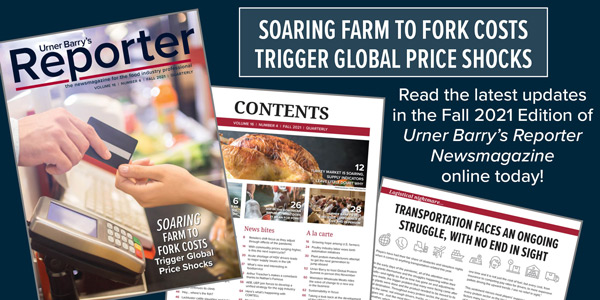REPORTER: Transportation Faces an Ongoing Struggle with No End in Sight
Friday, 01 October 2021October 1, 2021
This article was originally featured in the Fall 2021 Edition of Urner Barry's Reporter magazine.
 Players have had their fair share of obstacles and sleepless nights when it comes to anything transportation-related this year.
Players have had their fair share of obstacles and sleepless nights when it comes to anything transportation-related this year.
In the early days of the pandemic, all of the attention was on the plants themselves and the struggles happening within their walls—and rightly so. But as time has gone on and adjustments were made, the bigger problem that many were facing came after the plants were done and the product needed to be moved to its final destination. Throughout every protein sector, the problems were the same: not enough drivers, trucks, or containers (and the list goes on). Just like most things these days, if it is not one thing it’s another, which causes headaches, frustration, and costs for everyone involved.
Mark Liszt, President, and CEO of Lawrence Wholesale, a West Coast-based protein wholesaler provided his input on the current state of things on the domestic front:
“Domestic rates are on the rise, and truck availability is on the decline. Simply, there is too much cargo needing to move at one time and it is not just the cost of fuel, but every cost, from insurance to competing pay rates for drivers, to more expensive pallets driving the upward trends. I see no relief in sight.”
This sentiment mirrors most players’ experiences throughout every protein sector as the black and white supply and demand factors many have come to expect are no longer the main part of the equation.
Internationally, things are just as complicated, if not more so. Liszt explained, “Internationally, the system is simply overloaded. We all read about port congestion, but when you see it, you understand better. The boats are lined up for as far as the eye can see. This is not just at the destination port, but at the transfer ports as well when containers move to the mother boats from the feeder boats. Thus, transit time is at least double. If a container line can charge for his container usage less times a year, he raises his prices as his costs are higher. When 100 people call you for the 10 containers you have available, you raise your prices. Welcome to moving goods in 2021.”
While container availability is certainly top of mind for most, other players have shifted their focus to other pressing issues, where just getting product out of the plants and to the ports is the biggest obstacle at hand. Some processors have even gone as far as shifting production from one plant to another simply because it’s closer to a port city and reduces their freight costs and the need to find drivers and trucks.
However, that isn’t the only issue at hand as countries around the world continue to struggle with COVID-related obstacles which further dampen potential exploits in the arena going forward. The story nowadays has shifted to Southeast Asia and their country-by-country shutdowns. This isn’t just affecting U.S. players in their ability to market and ship product for export, but also players that import seafood who are grappling with these latest setbacks, which puts into question already thin product availability for the year and into 2022. With much of the industry already running on fumes, this news is just another setback in a year full of them.
With all these problems and more at play and no sign of an upcoming reprieve, players are grasping at straws to find any positives to take away from the current status quo. That’s not to say the incremental improvements aren’t noted, but in the grand scheme of things and from a mile-high view, the issues at play don’t appear to be improving all that much. All participants can do at this point, is pinch themselves and hope it wakes them from this nightmare.
Matt Busardo
Urner Barry
1-732-240-5330 ext 250
mbusardo@urnerbarry.com
